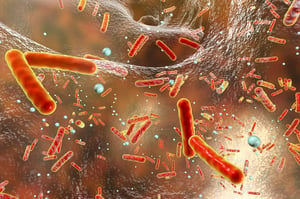The bacteria that populate our intestine (microbioma) never cease to amaze: a group of researchers from the University of Berkeley, California (USA), has just discovered that many of these microorganisms are able to generate electricity (albeit very weak), just like other bacteria that live in extreme conditions, such as in volcanoes or caves (and this is why they are called extremophiles). According to the journal nature, in fact, the intestine is also a kind of extreme environment, where oxygen is in short supply, there is no light and where many reactions complicate the life of these microorganisms. The majority of these bacteria play a position role in our lives but, in several cases, they are pathogens that try desperately to reproduce, or at least to stay alive.
Among the latter, those that have demonstrated that they can produce electricity – all defined gram-positive bacteria (in technical terms) – include listerias, responsible for food-borne infections, several of which are deadly, clostridia that cause gas gangrene, and enterococci that cause hospital infections. Among the beneficial ones, on the other hand, the Californian researchers have identified various lactobacilli, which are important probiotics and are also used in industrial fermentation: for example, to make yogurt.
However, the scientists have gone one step further and have also identified the way that intestinal bacteria produce electricity: unlike animals and plants, since they cannot rely on oxygen to discharge the electrons they produce during normal metabolic reactions, the extremophiles use whatever they find, i.e. usually metals like iron or manganese, thanks to a cascade of chemical events known as an extracellular electron transfer chain (and it is this chain that produces the electricity). In the intestine this chain, more simply, is not based on metals but on components of vitamin B12, such as Flavin (because it is easily present), and appears to start working when conditions require it. The researchers also used an electrode to measure the current produced, recording a result of 500 microamperes.
This information could have multiple applications in the field of bioenergy (for example, the electricity produced by bacteria could be used to treat refuse or water), in industry (for example, in the manufacturing of dairy products) and, finally, for therapeutic purposes (through the alteration of the currents produced, if necessary).

